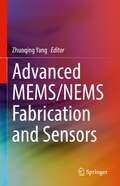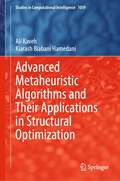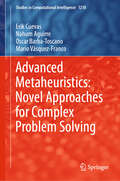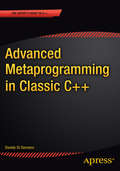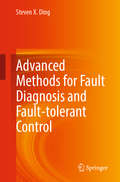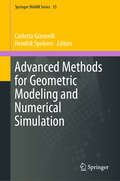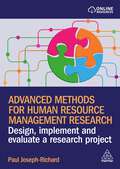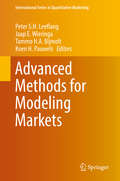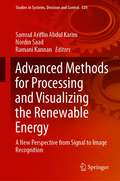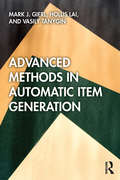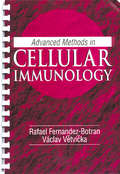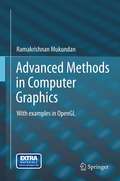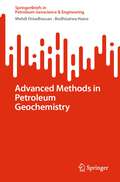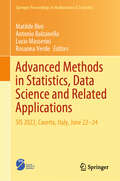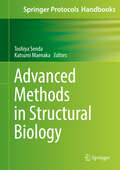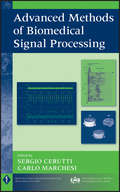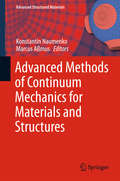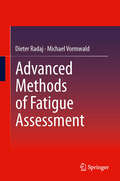- Table View
- List View
Advanced MEMS/NEMS Fabrication and Sensors
by Zhuoqing YangThis book begins by introducing new and unique fabrication, micromachining, and integration manufacturing methods for MEMS (Micro-Electro-Mechanical Systems) and NEMS (Nano-Electro-Mechanical Systems) devices, as well as novel nanomaterials for sensor fabrications. The second section focuses on novel sensors based on these emerging MEMS/NEMS fabrication methods, and their related applications in industrial, biomedical, and environmental monitoring fields, which makes up the sensing layer (or perception layer) in IoT architecture. This authoritative guide offers graduate students, postgraduates, researchers, and practicing engineers with state-of-the-art processes and cutting-edge technologies on MEMS /NEMS, micro- and nanomachining, and microsensors, addressing progress in the field and prospects for future development.Presents latest international research on MEMS/NEMS fabrication technologies and novel micro/nano sensors;Covers a broad spectrum of sensor applications;Written by leading experts in the field.
Advanced Metaheuristic Algorithms and Their Applications in Structural Optimization (Studies in Computational Intelligence #1059)
by Ali Kaveh Kiarash Biabani HamedaniThe main purpose of the present book is to develop a general framework for population-based metaheuristics based on some basic concepts of set theory. The idea of the framework is to divide the population of individuals into subpopulations of identical sizes. Therefore, in each iteration of the search process, different subpopulations explore the search space independently but simultaneously. The framework aims to provide a suitable balance between exploration and exploitation during the search process. A few chapters containing algorithm-specific modifications of some state-of-the-art metaheuristics are also included to further enrich the book. The present book is addressed to those scientists, engineers, and students who wish to explore the potentials of newly developed metaheuristics. The proposed metaheuristics are not only applicable to structural optimization problems but can also be used for other engineering optimization applications. The book is likely to be of interest to a wide range of engineers and students who deal with engineering optimization problems.
Advanced Metaheuristics: Novel Approaches for Complex Problem Solving (Studies in Computational Intelligence #1210)
by Erik Cuevas Nahum Aguirre Oscar Barba-Toscano Mario Vásquez-FrancoThis book examines a series of strategies designed to enhance metaheuristic algorithms, focusing on critical aspects such as initialization methods, the incorporation of Evolutionary Game Theory to develop novel search mechanisms, and the application of learning concepts to refine evolutionary operators. Furthermore, it emphasizes the significance of diversity and opposition in preventing premature convergence and improving algorithmic efficiency. These strategies collectively contribute to the development of more adaptive and robust optimization techniques. The book was designed from a teaching standpoint, making it suitable for undergraduate and postgraduate students in Science, Electrical Engineering, or Computational Mathematics. Furthermore, engineering practitioners unfamiliar with metaheuristic computations will find value in the application of these techniques to address complex real-world engineering problems, extending beyond theoretical constructs.
Advanced Metal Ion Storage Technologies: Beyond Lithium-Ion Batteries
by Ranjusha Rajagopalan Haiyan Wang Yougen TangThis book focusses on the current research on materials for advanced battery technologies and proposes future directions for different types of batteries to meet the current challenges associated with the fuel cell. Furthermore, it provides insights into scientific and practical issues in the development of various batteries like sodium, potassium, zinc, magnesium, aluminum, calcium, and dual metal ion, to bring a new perspective to storage technologies beyond lithium-ion batteries. It introduces different themes of batteries to evaluate the opportunities and challenges of these battery systems from a commercial aspect. Key features: Deals with different potential rechargeable battery systems as suitable substitutes for LIBs Discusses different investigated materials as anode, cathode, and electrolytes for different energy storage systems Provides a complete and comprehensive review of all the existing metal-ion batteries Includes practical challenges and future opportunities of each battery category Reviews commercial aspects of different battery systems This book is aimed at researchers, graduate students, and professionals in industrial and applied chemistry, renewable energy, clean and sustainable processes, chemical engineering, materials science, nanotechnology, and battery chemistry.
Advanced Metaprogramming in Classic C++
by Davide Di GennaroTake a detailed and intense look into template metaprogramming (TMP) using classic C++. Tackle language aspects, design patterns, examples and applications, with special emphasis on small reusable techniques that will improve the quality of daily work. Advanced Metaprogramming in Classic C++: Third Edition is a book to sit with and learn from. Users of its prior editions point out that they come back to it over and over. This edition enhances the readability and clarity of the discussion. The two newer standards are not used in the code so that the examples can be rich, illustrate the point, and be run with confidence. The code can be readily adapted to include the elements of the Modern C++ standards. The gain for the reader is that TMP is presented in the book as a set of techniques that will enable a new style to your C++ coding while making it exceptionally clear and efficient. The approach in the book is used to maximize compatibility and clearly illustrate the techniques, enabling the reader to comprehend difficult material without the burdens of compiler errors, and other unnecessary complexities and enabling a much more intense treatment of the subject. For those interested in Modern C++, all subsequent additions to the C++ language are fully compatible with the code in this book and users familiar with them can leverage the techniques introduced in C++XX to make the patterns in this book even more powerful. There is a chapter that discusses issues regarding the two newer standards and the basics needed to program for the newer standards are readily available online. What makes the book exceptional is the level of understanding of the concepts involved imparted by the author. This is not just a rote overview of metaprogramming. You will truly understand difficult topics like static assertions, how to write metafunctions, overload resolution, lambda expressions, and many others. More than that, you will work through them with practical examples guided by the author's frank explanations. This book requires you to think and to learn and to understand the language so that you can program at a higher level. What you'll learn What templates and the small object toolkit are, and how to use them How to do overload resolution How to do metaprogramming with interfaces, algorithms, functors and refactoring How to work with code generators What is opaque type principle and how to use it How to work with debugging templates and more A chapter devoted to issues surrounding C++0x and C++14 Who this book is for This book is for experienced C++ programmers who want to learn more. Table of Contents Part I 1. Templates 2. Small Object Toolkit Part II 3. Static Programming 4. Overload Resolution 5. Interfaces 6. Algorithms 7. Code Generators 8. Functors 9. Opaque Type Principle Part III 10. Refactoring 11. Debugging Templates 12. C++0X 13. Appendix A: Exercises 14. Appendix B: Bibliography
Advanced Methodologies for Bayesian Networks: Second International Workshop, AMBN 2015, Yokohama, Japan, November 16-18, 2015. Proceedings (Lecture Notes in Computer Science #9505)
by Joe Suzuki Maomi UenoThis volume constitutes the refereed proceedings of the Second International Workshop on Advanced Methodologies for Bayesian Networks, AMBN 2015, held in Yokohama, Japan, in November 2015. The 18 revised full papers and 6 invited abstracts presented were carefully reviewed and selected from numerous submissions. In the International Workshop on Advanced Methodologies for Bayesian Networks (AMBN), the researchers explore methodologies for enhancing the effectiveness of graphical models including modeling, reasoning, model selection, logic-probability relations, and causality. The exploration of methodologies is complemented discussions of practical considerations for applying graphical models in real world settings, covering concerns like scalability, incremental learning, parallelization, and so on.
Advanced Methods and Technologies in Metallurgy in Russia (Innovation and Discovery in Russian Science and Engineering)
by Stavros Syngellakis Jerome J ConnorThe book provides a comprehensive overview of the most recent and advanced work on metallurgy sciences and technologies--including material characterization of complicated alloys, heat and surface treatment, ferrous metals metallurgy, and energy savings in pyrometallurgy--in the important Ural industrial region of Russia. Until recently, research into scientific and engineering problems within Russia developed along different lines than those in Europe and North America, but nevertheless resulted in remarkable achievements utilizing different tools and methodologies than those used in the West. Many of these achievements - particularly in metallurgy - were made in the Urals.
Advanced methods for fault diagnosis and fault-tolerant control
by Steven X. DingThe major objective of this book is to introduce advanced design and (online) optimization methods for fault diagnosis and fault-tolerant control from different aspects. Under the aspect of system types, fault diagnosis and fault-tolerant issues are dealt with for linear time-invariant and time-varying systems as well as for nonlinear and distributed (including networked) systems. From the methodological point of view, both model-based and data-driven schemes are investigated.To allow for a self-contained study and enable an easy implementation in real applications, the necessary knowledge as well as tools in mathematics and control theory are included in this book. The main results with the fault diagnosis and fault-tolerant schemes are presented in form of algorithms and demonstrated by means of benchmark case studies. The intended audience of this book are process and control engineers, engineering students and researchers with control engineering background.
Advanced Methods for Geometric Modeling and Numerical Simulation (Springer INdAM Series #35)
by Carlotta Giannelli Hendrik SpeleersThis book gathers selected contributions presented at the INdAM Workshop “DREAMS”, held in Rome, Italy on January 22−26, 2018. Addressing cutting-edge research topics and advances in computer aided geometric design and isogeometric analysis, it covers distinguishing curve/surface constructions and spline models, with a special focus on emerging adaptive spline constructions, fundamental spline theory and related algorithms, as well as various aspects of isogeometric methods, e.g. efficient quadrature rules and spectral analysis for isogeometric B-spline discretizations. Applications in finite element and boundary element methods are also discussed. Given its scope, the book will be of interest to both researchers and graduate students working in these areas.
Advanced Methods for Human Biometrics (Smart Sensors, Measurement and Instrumentation #40)
by Nabil Derbel Olfa KanounThe book highlights recent developments in human biometrics, covering a wide range of methods based on biological signals, image processing, and measurements of human characteristics such as fingerprints and iris or medical characteristics. Human Biometrics is becoming increasingly crucial in forensics security and medicine. They provide a solid basis for identifying individuals based on unique physical characteristics or diseases based on characteristic biomedical measurements. As such, the book offers an essential reference guide about biometry methods for students, engineers, designers, and technicians.
Advanced Methods for Human Resource Management Research: Design, Implement and Evaluate a Research Project
by Paul Joseph-RichardUnderstanding and applying research methods is a key skill in human resource management. This new textbook shows how to successfully complete a research project across the HR function.Advanced Methods for Human Resource Management Research provides a practice-based approach to planning and implementing research projects. Each chapter focuses on one HRM practice and a 'Method in Focus' feature that shows how a particular method could be used for researching that practice. This enables postgraduate Research Methods students to gain an understanding of how research may be most effectively conducted for different aspects of HR, from recruitment, selection and people analytics to learning and development, sustainable HRM and employee wellbeing.This book offers comprehensive guidance on what kinds of questions can be asked and the application of current designs and methods. Readers will learn how to conduct both qualitative and quantitative research, such as interviews and literature reviews, using Big Data, social media and visuals, as well as creating cross-country designs to engage international participants. It is supported by learning outcomes, real-world examples, discussion questions and 'ethical dilemma' exercises to develop critical understanding of the material. Online resources include lecturer slides, annotated web links, further reading and new reflective questions for students.This textbook is written for postgraduate HR students taking Research Methods modules as part of their degree.
Advanced Methods for Modeling Markets (International Series in Quantitative Marketing)
by Peter S. H. Leeflang Jaap E. Wieringa Koen H. Pauwels Tammo H.A BijmoltThis volume presents advanced techniques to modeling markets, with a wide spectrum of topics, including advanced individual demand models, time series analysis, state space models, spatial models, structural models, mediation, models that specify competition and diffusion models. It is intended as a follow-on and companion to Modeling Markets (2015), in which the authors presented the basics of modeling markets along the classical steps of the model building process: specification, data collection, estimation, validation and implementation. This volume builds on the concepts presented in Modeling Markets with an emphasis on advanced methods that are used to specify, estimate and validate marketing models, including structural equation models, partial least squares, mixture models, and hidden Markov models, as well as generalized methods of moments, Bayesian analysis, non/semi-parametric estimation and endogeneity issues. Specific attention is given to big data. The market environment is changing rapidly and constantly. Models that provide information about the sensitivity of market behavior to marketing activities such as advertising, pricing, promotions and distribution are now routinely used by managers for the identification of changes in marketing programs that can improve brand performance. In today's environment of information overload, the challenge is to make sense of the data that is being provided globally, in real time, from thousands of sources. Although marketing models are now widely accepted, the quality of the marketing decisions is critically dependent upon the quality of the models on which those decisions are based. This volume provides an authoritative and comprehensive review, with each chapter including: #65533; an introduction to the method/methodology #65533; a numerical example/application in marketing #65533; references to other marketing applications #65533; suggestions about software. Featuring contributions from top authors in the field, this volume will explore current and future aspects of modeling markets, providing relevant and timely research and techniques to scientists, researchers, students, academics and practitioners in marketing, management and economics.
Advanced Methods for Processing and Visualizing the Renewable Energy: A New Perspective from Signal to Image Recognition (Studies in Systems, Decision and Control #320)
by Ramani Kannan Nordin Saad Samsul Ariffin Abdul KarimThis book is a collection of research work conducted by researchers at Centre for Smart Grid Energy Research (CSMER), Institute of Autonomous System, Universiti Teknologi PETRONAS (UTP), and Seismic Modelling and Inversion Group, King Abdullah University of Science and Technology (KAUST), Saudi Arabia. The book covers topics in the field of renewable energy where visualization, artificial neural network and deep learning techniques have been applied to optimize the performance of various applications in energy-related industries. These examples include a natural gas vehicle (NGV), a single axis and a fixed axis solar tracker, seismic inversion enhanced oil recovery, viability of a PV system and construction of a septic B-spline tensor product scheme. Readers will benefit from these examples, which describe the current trend of energy optimization techniques in renewable energy applications making it a good reference for the researchers and industrial practitioners working in the field of renewable energy and optimization techniques.
Advanced Methods in Automatic Item Generation
by Mark J. Gierl Hollis Lai Vasily TanyginAdvanced Methods in Automatic Item Generation is an up-to-date survey of the growing research on automatic item generation (AIG) in today’s technology-enhanced educational measurement sector. As test administration procedures increasingly integrate digital media and Internet use, assessment stakeholders—from graduate students to scholars to industry professionals—have numerous opportunities to study and create different types of tests and test items. This comprehensive analysis offers thorough coverage of the theoretical foundations and concepts that define AIG, as well as the practical considerations required to produce and apply large numbers of useful test items.
Advanced Methods in Cellular Immunology
by Rafael Fernandez-Botran Vaclav VetvickaImmunologists as well investigators in other disciplines may often use protocols involving the isolation, cultures and characterization of different types of leukocytes. Advanced Methods in Cellular Immunology is a collection of techniques in an easy-to-use format.Each chapter provides readers with related program information, a step-by-step de
Advanced Methods in Computer Graphics: With examples in OpenGL
by Ramakrishnan MukundanThis book brings together several advanced topics in computer graphics that are important in the areas of game development, three-dimensional animation and real-time rendering. The book is designed for final-year undergraduate or first-year graduate students, who are already familiar with the basic concepts in computer graphics and programming. It aims to provide a good foundation of advanced methods such as skeletal animation, quaternions, mesh processing and collision detection. These and other methods covered in the book are fundamental to the development of algorithms used in commercial applications as well as research.
Advanced Methods in Family Therapy Research: A Focus on Validity and Change
by Lee N. Johnson Richard B MillerResearch is vital in moving the field of family therapy forward, but the myriad of possibilities inherent in working with systems and individuals can overwhelm even the most seasoned researcher. Advanced Methods in Family Therapy Research is the best resource to address the day-to-day questions that researchers have as they investigate couples and families, and the best source for learning long-term theory and methodology. The contributors of this volume share their wisdom on a wide variety of topics including validity concerns, measuring interpersonal process and relational change, dyadic data analysis (demonstrated through a sample research study), mixed methods studies, and recruitment and retention. The volume contains one of the most detailed descriptions of data collections and covers interviewing, using questionnaires, and observing brain activity. Also addressed are suggestions to meaningfully reduce cultural bias, to conduct ethical research, and, in the Health Services Research chapter, to examine interventions for clients in various income brackets. A separate, ground-breaking chapter also addresses psychophysiological research in a couple and family therapeutic context. As an added benefit, readers will learn how to become informed consumers of journal articles and studies, how to produce quality, publishable research, and how to write fundable grant proposals. Each chapter provides a clear and detailed guide for students, researchers, and professionals, and as a whole Advanced Methods in Family Therapy Research advances the field by teaching readers how to provide evidence that marriage and family therapy not only relieves symptoms, but also effects behavioral change in all family members.
Advanced Methods in Petroleum Geochemistry (SpringerBriefs in Petroleum Geoscience & Engineering)
by Mehdi Ostadhassan Bodhisatwa HazraThis brief presents recent developments and new methodologies in the area of petroleum geochemistry, including innovative unconventional analytical methods such as Raman, NMR and XPS spectroscopy that are based on advanced analytical chemistry and recently developed instrumentation. It discusses delineating mechanisms for petroleum generation, expulsion, migration and accumulation in reservoirs from the source rock. This brief provides data, illustrations and detailed explanation of each method discussed, as well as data collection, interpretation of the results and intercorrelated characteristics of different case studies from a variety of samples. Geologists, engineers, and graduate students interested in the petroleum industry will all find the book valuable.
Advanced Methods in Statistics, Data Science and Related Applications: SIS 2022, Caserta, Italy, June 22–24 (Springer Proceedings in Mathematics & Statistics #467)
by Matilde Bini Antonio Balzanella Lucio Masserini Rosanna VerdeThis book contains a selection of the improved contributions submitted by participants at the conference of the Italian Statistical Society - SIS 2022 held in Caserta 22-24 June 2022. The scientific community of Italian statistics, which gathers around the SIS, is paying particular attention to the development of statistical techniques increasingly oriented toward the processing of large data, mainly, of complex data. The main goal is to provide the analysis of the data and the interpretability of the obtained results, with a view to decision support and the reliability of the data outcomes. The aim of this volume is to show some of the most relevant contributions of statistical and data analysis methods in preserving the quality of the information to be processed, especially when it comes from different, often non-official sources; as well as in the extraction of knowledge from complex data (textual, network, unstructured and multivalue) and in the explicability of results. Data Science today represents a broad domain of knowledge development from data, where statistical and data analysis methods can make an important contribution in the different domains where data management and processing are required. This volume is addressed to researchers but also to Ph.D. and MSc students in the field of Statistics and Data Science to acquaint them with some of the most recent developments towards which statistical research is orienting, in prevalence in Italy.
Advanced Methods in Structural Biology (Springer Protocols Handbooks)
by Toshiya Senda Katsumi MaenakaThis book provides practical information on a whole set of protein experiments for advanced structural biology, such as X-ray crystallography, NMR, electron microscopy, advanced mass spectroscopy, and surface plasmon resonance, as well as a wide variety of expression systems including eukaryotic and in vitro expression. In the past decade, structural genomics studies have pushed forward the development of automated methods in the field of structural biology, however there is an increasing need for the structural analysis of difficult targets, such as large protein complexes and membrane proteins, which are hard to achieve using conventional automated methods, and require knowledge that goes beyond standard protein chemistry protocols. To address these problems and to help researchers develop novel methods, this volume provides examples of the development of new protein investigation methods and their theoretical background. This book particularly appeals to graduate students, postdoctoral researchers, young investigators wishing to gain a better understanding of the theory behind experiments, and those seeking further advanced, practical structural biology methods.
Advanced Methods in Structural Biology (Methods in Molecular Biology #2652)
by Ângela Sousa Luis PassarinhaThis volume explores the latest integrated bioprocesses and technologies used to study the production of the target recombinant protein of therapeutic or diagnostic interest; its isolation, purification, and stabilization; and the bio-interaction and structural analyses. The chapters in this book are organized into four parts. Part One covers production methods of soluble and membrane proteins in prokaryotic and eukaryotic expression systems, such as Lactococcus lactis and Escherichia coli. Part Two describes traditional and novel approaches for recombinant protein purification and stabilization, and buffers and additives. Part Three discusses automated methods in structural biology based on in silico approaches; and Part Four provides examples of advanced protein investigation methodologies to assess structural analysis such as high-throughput protein crystallization and time-resolved serial crystallography. Written in the highly successful Methods in Molecular Biology series format, chapters include introductions to their respective topics, lists of the necessary materials and reagents, step-by-step, readily reproducible laboratory protocols, and tips on troubleshooting and avoiding known pitfalls.Cutting-edge and comprehensive, Advanced Methods in Structural Biology is a valuable resource to those in academia (i.e., graduate students and postdoctoral researchers) and researchers in the pharmaceutical industry who wish to learn more about this developing field. Chapter 5 is available open access under a Creative Commons Attribution 4.0 International License via link.springer.com.
Advanced Methods in the Fractional Calculus of Variations (SpringerBriefs in Applied Sciences and Technology)
by Agnieszka B. Malinowska Tatiana Odzijewicz Delfim F.M. TorresThis brief presents a general unifying perspective on the fractional calculus. It brings together results of several recent approaches in generalizing the least action principle and the Euler-Lagrange equations to include fractional derivatives. The dependence of Lagrangians on generalized fractional operators as well as on classical derivatives is considered along with still more general problems in which integer-order integrals are replaced by fractional integrals. General theorems are obtained for several types of variational problems for which recent results developed in the literature can be obtained as special cases. In particular, the authors offer necessary optimality conditions of Euler-Lagrange type for the fundamental and isoperimetric problems, transversality conditions, and Noether symmetry theorems. The existence of solutions is demonstrated under Tonelli type conditions. The results are used to prove the existence of eigenvalues and corresponding orthogonal eigenfunctions of fractional Sturm-Liouville problems. Advanced Methods in the Fractional Calculus of Variations is a self-contained text which will be useful for graduate students wishing to learn about fractional-order systems. The detailed explanations will interest researchers with backgrounds in applied mathematics, control and optimization as well as in certain areas of physics and engineering.
Advanced Methods of Biomedical Signal Processing (IEEE Press Series on Biomedical Engineering #27)
by Sergio Cerutti Carlo MarchesiThis book grew out of the IEEE-EMBS Summer Schools on Biomedical Signal Processing, which have been held annually since 2002 to provide the participants state-of-the-art knowledge on emerging areas in biomedical engineering. Prominent experts in the areas of biomedical signal processing, biomedical data treatment, medicine, signal processing, system biology, and applied physiology introduce novel techniques and algorithms as well as their clinical or physiological applications. The book provides an overview of a compelling group of advanced biomedical signal processing techniques, such as multisource and multiscale integration of information for physiology and clinical decision; the impact of advanced methods of signal processing in cardiology and neurology; the integration of signal processing methods with a modelling approach; complexity measurement from biomedical signals; higher order analysis in biomedical signals; advanced methods of signal and data processing in genomics and proteomics; and classification and parameter enhancement.
Advanced Methods of Continuum Mechanics for Materials and Structures (Advanced Structured Materials #60)
by Konstantin Naumenko Marcus AßmusThis volume presents a collection of contributions on advanced approaches of continuum mechanics, which were written to celebrate the 60th birthday of Prof. Holm Altenbach. The contributions are on topics related to the theoretical foundations for the analysis of rods, shells and three-dimensional solids, formulation of constitutive models for advanced materials, as well as development of new approaches to the modeling of damage and fractures.
Advanced Methods of Fatigue Assessment
by Dieter Radaj Michael VormwaldIn five chapters, this volume presents recent developments in fatigue assessment. In the first chapter, a generalized Neuber concept of fictitious notch rounding is presented where the microstructural support factors depend on the notch opening angle besides the loading mode. The second chapter specifies the notch stress factor including the strain energy density and J-integral concept while the SED approach is applied to common fillet welded joints and to thin-sheet lap welded joints in the third chapter. The forth chapter analyses elastic-plastic deformations in the near crack tip zone and discusses driving force parameters. The last chapter discusses thermomechanical fatigue, stress, and strain ranges.
